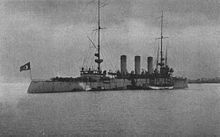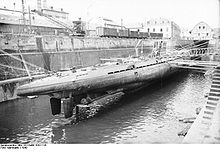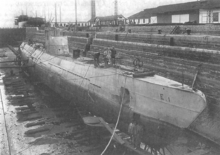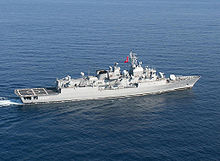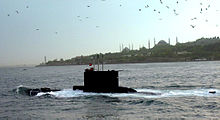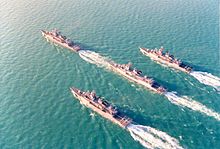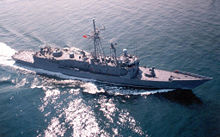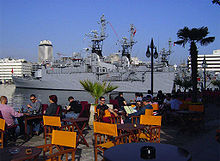Turkish Navy
- Turkish Navy
-
The Turkish Navy (Turkish: Türk Deniz Kuvvetleri) is the naval warfare service branch of the Turkish Armed Forces.
History
Ottoman fleet after Mudros
Following the demise of the Ottoman Empire in the aftermath of World War I, on November 3, 1918, the fleet commander of the Ottoman Navy, Liva Amiral Arif Pasha, ordered all flags to be struck on all warships lying in the Golden Horn and the Ottoman Navy ceased to exist.[3] The major surface combatants of the former Ottoman fleet (totalling 62,000 tons) were rendered inactive by the Allies and in accordance with the terms of the Armistice of Mudros, the warships were disarmed during the last week of 1918. The battleship Turgut Reis and the cruisers Hamidiye and Mecidiye were substantially limited and kept inactive inside the Golden Horn by the occupying forces.[4] Due to its larger size, the battlecruiser Yavuz Sultan Selim was transferred to the Gulf of Izmit on the grounds that she could adversely affect the sea traffic inside the Golden Horn;[4] while her ammunition and guns were removed.[4] During this period, only a small number of Ottoman Navy vessels were allowed by the Allies to remain on active coast guard duties and were released from internment on 26 February 1919;[3] such as the torpedo boats Akhisar and Draç which patrolled the Sea of Marmara, the gunboat Hızır Reis which patrolled the Gulf of İzmir, and the minelayers Nusret and Tir-i Müjgan which conducted mine cleaning operations in the Gulf of Saros.[4]
Before the Turkish War of Independence began, the Bahriye Nazırlığı (Naval Ministry) sent the gunboat Preveze to Sinop and the gunboat Aydın Reis to Trabzon in February 1919 for surveillance, reconnaissance and patrol duties.[4] However, a lack of coal to fuel their propulsion systems caused the Preveze and Aydın Reis to remain in harbour until the end of 1919.[4] During the early stages of the Turkish War of Independence, these two gunboats did not return to Istanbul, despite heavy pressure from the Ottoman government and the Allies.[4] Instead, they were placed under the command of the Turkish liberation forces led by Mustafa Kemal Atatürk and headquartered in Ankara.[4]
Turkish War of Independence
Directorate of Naval Affairs
A large number of the naval officers and students of the Naval Academy went to Anatolia for participating in the Turkish War of Independence. On 10 July 1920, the Directorate of Naval Affairs (Umur-u Bahriye Müdürlüğü) was founded in Ankara under the Ministry of National Defense and was given the duty of organizing and maintaining strategic logistical shipping through the Black Sea in order to provide the Turkish liberation forces in Anatolia with weapons and other supplies.[4] All existing naval institutions in the parts of Anatolia that were administered by the Ankara government were assigned to this Directorate.[4] The Directorate of Naval Affairs was extremely successful in organizing local surface units and volunteers and in forming an intelligence network to discover the movements of the enemy ships.[4] As a result, logistic transportation was carried out effectively.[4] The Turkish Grand National Assembly in Ankara made an agreement with the Soviet Union to procure supplies for the Turkish liberation forces.[4] Aydın Reis left from Samsun (on 16 September 1920) and Preveze left from Trabzon (on 30 September 1920) for Novorossiysk in order to transport weapons, other supplies and financial aid to the Turkish liberation forces.[3][4] The Trabzon Shipping Detachment, which was founded on 21 September 1920, was renamed as the Trabzon Naval Shipping Command with the directive issued by the Ministry of National Defense on 26 October 1920.[4] On January 1, 1921, the Samsun Naval Command was formed.[5] In the subsequent stages of the Turkish War of Independence, due to the growing need for maritime shipping and the increase in the quantity and quality of the units and small ships, the organizational structure of the Directorate of Naval Affairs was gradually extended.[4]
In the same period, a number of Turkish civilian seamen formed a group under the name of the Naval Aid Organization (Muavenet-i Bahriye).[5] This group secretly obtained cannons, light weapons, ammunition, landmines and ordnance from the former Ottoman military warehouses in Istanbul that were under the control of the occupying Allies and sent them to the Turkish liberation forces in Anatolia with civil water transportation crafts.[5]
Presidency of the Naval Department
On 1 March 1921, the Directorate of Naval Affairs was transformed into the Presidency of the Naval Department (Bahriye Dairesi Reisliği) and had control over the Naval Commands in Samsun, Amasra and İzmit (formed on 28 June 1921); the Naval Transport Detachment in Trabzon; the Naval Transport Command in Ereğli; the Naval Detachment in Lake Eğirdir; and the Naval Liaison Group in Fethiye (formed on 16 March 1921.)[4] During the War of Independence, Turkish naval forces transported 220,000 tons of weapons, ammunition and equipment to the land forces in Anatolia.[5]
Ministry of the Navy

Turkish cruiser Peyk-i Şevket and its identical sister ship Berk-i Satvet were renamed as Peyk and Berk in 1924.
Following the Armistice of Mudanya on 11 October 1922, the former Ottoman Ministry of the Navy (Bahriye Nazırlığı) building in the Kasımpaşa quarter of Istanbul, on the Golden Horn, became the headquarters of the Istanbul Naval Command on 14 November 1922.[4]
The establishment of the Ministry of the Navy (Bahriye Vekâleti) of the Republic of Turkey, headquartered in Ankara, was decided by the Grand National Assembly on 29 December 1924, and Topçu İhsan Bey (İhsan Eryavuz) was appointed the first (and only) Naval Minister of Turkey.[6][7]
When the Republic of Turkey was established on 29 October 1923, the former Ottoman vessels that remained under Turkish control were as follows:[8]
In active service: 2 cruisers (Hamidiye,
During the 1920s, a commitment to refurbish the battlecruiser TCG Yavuz (which remained in active service until 1950) as the centerpiece of the republic's fleet was the only constant element of the various naval policies which were put forward.[9] The battlecruiser remained in İzmit until 1926, in a neglected state:[10][11][12] only two of her boilers worked, she could not steer or steam, and she still had two unrepaired scars from the mine damage in 1918. Enough money was raised to allow the purchase of a new 26,000-metric-ton (26,000-long-ton) floating dock from the German company Flender,[4] as Yavuz could not be towed anywhere without risk of her sinking in rough seas.[13] The French company Atelier et Chantiers de St. Nazaire-Penhöet was contracted in December 1926 to oversee the subsequent refit, which was carried out by the Gölcük Naval Shipyard.[11] Since the Treaty of Lausanne in 1923 required the disarmament of the Turkish Straits, the infrastructures belonging to the Turkish Naval Forces on the Bosphorus (in Istinye) and on the Golden Horn were transferred to Gölcük.[4] In this period, Gölcük was designated as the main Turkish naval base.[4]
The overhaul works of TCG Yavuz proceeded over three years (1927–1930); they were delayed when several compartments of the dock collapsed while being pumped out. Yavuz was slightly damaged before she could be refloated and the dock had to be repaired before the overhaul works could be resumed. The Minister of the Navy, İhsan Eryavuz, was convicted of embezzlement in the resulting investigation which became known as the Yavuz-Havuz case (havuz meaning "dock" in Turkish naval engineering terminology.)[13] The investigation revealed that Ihsan Eryavuz had reduced the insurance obligation of the French company (Atelier et Chantiers de St. Nazaire-Penhöet) from 5 million to 1.5 million Turkish liras, and was found guilty of fraud,[14] which resulted in the abolition of the Ministry of the Navy on 27 December 1927.[5][15]
Undersecretariat of the Sea
Following the dissolution of the Ministry of the Navy, the naval forces were reorganized under the Ministry of National Defense[7] and on 16 January 1928[15] the Undersecretariat of the Sea (Deniz Müsteşarlığı) was established in order to undertake the duties of the former Ministry of the Navy.[5] With this new reorganization, the Turkish Fleet Command was put under the command of the Turkish General Staff in terms of administration and logistics.[4]
On 2 November 1930, the Naval War College (Deniz Harp Akademisi) commenced training and education of Staff Officers at its facilities in the Yıldız Palace.[4] During World War II, the naval schools were temporarily relocated from Istanbul to Mersin for security reasons and conducted education and training activities in this city.[4]
In 1933, with the approval of the Turkish Grand National Assembly, Gölcük was designated as the main base of the Turkish Navy.[4] In the same year, the first new ship built at the Gölcük Naval Shipyard, the tanker TCG Gölcük, was laid down, and launched the following year.[4]
With the signing of the Montreaux Convention in 1936, Turkey’s sovereignty over the Turkish Straits was internationally recognized, and Fortified Area Commands were founded on the Bosphorus and Dardanelles straits, with Naval Detachments assigned to these Commands.[4]
Naval Forces Command
The Turkish Naval Forces were represented under the title of the Naval Undersecreteriat at the Turkish General Staff Headquarters in Ankara from 1928 to 1949.[4] The historic decree of the Higher Military Council on 15 August 1949 led to the foundation of the Turkish Naval Forces Command (Deniz Kuvvetleri Komutanlığı.)[4]
After Turkey joined NATO on 18 February 1952, the Turkish Naval Forces were integrated into the organizational branches of the alliance.[4]
In 1961, the Turkish Naval Forces Command was organized into four main subordinate commands: The Turkish Fleet Command, the Turkish Northern Sea Area Command, the Turkish Southern Sea Area Command and the Turkish Naval Training Command.[4] In 1995, the Turkish Naval Training Command was renamed as the Turkish Naval Training and Education Command.[4]
Today, the Turkish Navy numbers 48,600 active personnel;[2] and the total fleet displacement appears to be approximately 259,000 tons.[16]
Ship and submarine classes of the Turkish fleet since 1923
Further information: List of Turkish Navy ships
Interwar years
The aging warships inherited from the Ottoman Navy were mostly built and commissioned before the First World War, and technological improvements in naval warfare had left the Turkish Navy outdated in terms of equipment. To remedy this setback, the government of the Republic of Turkey embarked on a modernization program. First to be ordered were the two new submarines derived from the German Type UB III[17] and built by the German-owned Dutch shipyard IvS in 1925, being commissioned as the Birinci İnönü and İkinci İnönü in 1928. These were swiftly followed by an order for two submarines from Italy in 1930, which were named Sakarya and Dumlupınar, and commissioned in 1931 after an extremely fast build time at the Monfalcone Shipyard of CRDA.[18] The Navy also ordered four destroyers and three torpedo boats from Italian shipyards; namely the two Adatepe class destroyers (Adatepe and Kocatepe), the two Tınaztepe class destroyers (Tınaztepe and Zafer), and the three torpedo boats (Martı, Denizkuşu and Doğan), which were all commissioned in 1931. The Spanish-built submarine Gür, a variant of the German Type IA, was launched in 1930 and commissioned in 1936. Atatürk also ordered the Ay class submarines which were variants of the German Type IXA and were built by Krupp Germaniawerft at the shipyards of Kiel in Germany and Gölcük in Turkey. Yıldıray was laid down in 1936, but its commissioning was delayed until 1946 due to the hardships of the Second World War. Saldıray was laid down in 1937 and commissioned in 1939, while Atılay was laid down in 1937 and commissioned in 1940.
World War II
Following the death of Atatürk in 1938 and during the Second World War years under the presidency of İsmet İnönü, the Turkish Navy purchased the Oruç Reis class submarines which were designed and built by the Vickers-Armstrong Shipbuilders in England. Murat Reis and Oruç Reis were laid down in 1939 and commissioned in 1942, while Burak Reis-II was laid down in 1939 and commissioned in 1946. Turkey also purchased four destroyers and two minelayers from England in 1939. The four Demirhisar class destroyers were namely Gayret which was commissioned in 1940; and
Immediately after the end of the Second World War and with the declaration of the Truman Doctrine, which was followed a few years later by Turkey's membership to NATO in 1952, the Turkish fleet acquired new warships and submarines from the United States. Four Balao class submarines built by the General Dynamics Electric Boat Company joined the Turkish fleet and were commissioned in 1948. They were given the names of the previous Turkish submarines like TCG I. İnönü (S-330), TCG II. İnönü (S-331), TCG Sakarya (S-332) and TCG Gür (S-334). These were followed by the three GUPPY class submarines, namely TCG Turgutreis (S-342) which was commissioned in 1958, alongside TCG Pirireis (S-343) and TCG Hızırreis (S-344) which were commissioned in 1960; the GUPPY IA class submarine TCG Dumlupınar (S-339) which was commissioned in 1972, the seven GUPPY IIA class submarines which were commissioned between 1971 and 1973 and named as TCG Burakreis (S-335) (1971), TCG Uluçalireis (S-338) (1971), TCG Muratreis (S-336) (1971), TCG Cerbe (S-340) (1972), TCG I. İnönü (S-346) (1972), TCG Oruçreis (S-337) (1972) and TCG Preveze (S-345) (1973); the two GUPPY III class submarines which were commissioned in 1974 and named as TCG Çanakkale (S-341) and TCG II. İnönü (S-333), and the two Tang class submarines which were commissioned in 1980 and 1983, and named as TCG Pirireis (S-343) (1980) and TCG Hızırreis (S-342) (1983).
Between 1949 and 1950, four U.S.-built Gleaves class destroyers were acquired; namely TCG Gelibolu (D-346) and TCG Giresun (D-345) in 1949, and TCG Gaziantep (D-344) and TCG Gemlik (D-347) in 1950.
In 1959 four British-made M class destroyers joined the fleet, namely TCG Alp Alslan (D-348), TCG Kılıç Ali Paşa (D-350), TCG Mareşal Fevzi Çakmak (D-349) and Fletcher class destroyers were acquired by the Turkish Navy; namely the TCG İstanbul (D-340) and TCG İzmir (D-341) in 1967, and the TCG İçel (D-344), TCG İskenderun (D-343) and TCG İzmit (D-342) in 1969.
1970s
Starting from 1971, the Turkish Navy acquired a total of ten U.S.-built FRAM I Gearing class destroyers from the United States, namely TCG Adatepe (D-353) (1971), TCG Kocatepe (D-354) (1971), TCG Tınaztepe (D-355) (1972), TCG Gayret (D-352) (1973), TCG Mareşal Fevzi Çakmak (D-351) (1973), TCG Kocatepe (1974) (1974), TCG Savaştepe (D-348) (1979), TCG Piyale Paşa (D-350) (1980), TCG Kılıç Ali Paşa (D-349) (1980) and TCG Yücetepe (D-345) (1982). In 1981 and 1982, two Carpenter class anti submarine destroyers joined the fleet, namely TCG Anıttepe (D-347) (1981) and TCG Alçıtepe (D-346) (1982). Carpenter class was a modified version of the Gearing class destroyer.
Turkish-built (modified Claud Jones class destroyer escort) frigates Allen M. Sumner class destroyers, TCG Muavenet (DM-357) and TCG Zafer (D-356), were acquired by the Turkish Navy.
Type 209 submarines
The Turkish Navy has 14 non-nuclear German-designed Type 209 submarines,[19] which were built in Germany and Turkey. In the early 1970s, the Turkish Navy ordered six Atılay class (Type 209/1200) submarines, which were laid down between 1974 and 1988, and commissioned between 1976 and 1989, as Atılay (S-347) (1976), Saldıray (S-348) (1977), Batıray (S-349) (1978), Yıldıray-II (S-350) (1981), Doğanay (S-351) (1984) and Dolunay (S-352) (1989).
They were followed by the four Preveze class (Type 209T1/1400) submarines which were laid down between 1993 and 1998, and commissioned between 1994 and 1999, as Preveze (S-353) (1994), Sakarya (S-354) (1995), 18 Mart (S-355) (1998) and Anafartalar (S-356) (1999). The last four submarines, classified as the Gür class (Type 209T2/1400) were laid down between 2002 and 2006, and commissioned as Gür (S-357) (2003), Çanakkale (S-358) (2005), Burakreis (S-359) (2006) and II. İnönü (S-360) (2007).
At present, the Turkish Navy operates the largest fleet of German-designed submarines in the world.
1980s
In 1983 two German-built Köln class frigates, namely Gelibolu (D-360) and Gemlik (D-361), joined the Turkish fleet.
During the modernization programme of the Turkish fleet in the mid 1980s, the first MEKO class frigates, designed by the German shipbuilding company Blohm + Voss and built in Germany and Turkey, were acquired. Four Yavuz class frigates (MEKO 200TN Track I) were built; namely TCG Yavuz (F-240) which was launched in 1985 and commissioned in 1987, TCG Turgutreis (F-242) and TCG Fatih (F-241) which were launched in 1987 and commissioned in 1988, and TCG Yıldırım (F-243) which was launched in 1988 and commissioned in 1989.
1990s to 2000s
These were followed by the two Barbaros class frigates (MEKO 200TN Track IIA), of which Barbaros was launched in 1993 and commissioned in 1997, and TCG Oruçreis (F-245) was launched in 1994 and commissioned in 1997. The final two ships are classified as the Salih Reis class frigates (MEKO 200TN Track IIB), of which TCG Salihreis (F-246) was launched in 1997 and commissioned in 1998, and TCG Kemalreis (F-247) was launched in 1998 and commissioned in 2000. These ships are equipped with the Mk.41 vertical launching system.
In the early 1990s Turkey acquired eight U.S.-built Knox class frigates. TCG Muavenet (F-250), TCG Zafer (F-253), TCG Kocatepe (F-252), TCG Adatepe (F-251) were commissioned in 1993, while TCG Akdeniz (F-257), TCG Trakya (F-254), TCG Karadeniz (F-255) and TCG Ege (F-256) were commissioned in 1994. Five ships of this class have been decommissioned between 2001 and 2005. Currently only TCG Zafer is still in active service.
In the late 1990s Turkey acquired eight Oliver Hazard Perry (G class) frigates from the United States. TCG Gaziantep (F-490), TCG Giresun (F-491) and TCG Gemlik (F-492) were commissioned in 1998; TCG Gelibolu (F-493) and TCG Gökçeada (F-494) were commissioned in 1999; TCG Gediz (F-495) was commissioned in 2000; TCG Gökova (F-496) was commissioned in 2002; and TCG Göksu (F-497) was commissioned in 2003.
2000s
Between 2001 and 2003 a total of six French-built D'Estienne d'Orves class (B class) corvettes were acquired from France. Bozcaada was commissioned in 2001; Bodrum, Bandırma, Beykoz and Bartın were commissioned in 2002; and Bafra was commissioned in 2003.
On 26 July 2005, construction of the first Milgem class corvette, Heybeliada, began at the Istanbul Naval Shipyard. A total of twelve Milgem class corvettes will be built for the Turkish Navy.
Projects
Plans to build a total of four TF-2000 class AAW frigates,[20][21] the acquisition of a Landing Platform Dock (LPD)[22] and a total of six Type 214 AIP submarines[23][24][25] were approved by the Turkish Ministry of Defense on 12 December 2006. The RfI issued for the LPD project states that the requirement is for one LPD carrying 4 Landing Craft Mechanics (LCM), 27 Amphibious Assault Vehicles (AAV), 2 Landing Craft Personnel Vehicles (LCPV), 1 Commander Boat and 1 Rubber Hull Inflated Boat (RHIB). The Turkish Navy also plans to acquire 2 new Tank Landing Ships (LST),[26] 8 new Tank Landing Crafts (LCT),[27] 16 new Offshore Patrol Vessels (OPV) with ASW capability,[28] 2 new Rescue & Towing (R&T) ships,[29] 1 new Submarine Rescue Mother Ship (MOSHIP),[30] and a new Fleet Replenishment Tanker (FRT) class.[31]
Structure

Turkish frigate F-495 TCG
Gediz (center) escorting the U.S. aircraft carrier CVN-75 USS
Harry S. Truman (left) and the Italian aircraft carrier C-551 ITS
Giuseppe Garibaldi (right) during the NATO exercise
Majestic Eagle 2004 in the
Atlantic Ocean.
In 1961, the Turkish Naval Forces Command was organized into four main subordinate commands: The Turkish Fleet Command, the Turkish Northern Sea Area Command, the Turkish Southern Sea Area Command and the Turkish Naval Training Command.[4] In 1995, the Turkish Naval Training Command was renamed as the Turkish Naval Training and Education Command.[4]
- Fleet Command
- Surface Action Group Command, Gölcük Naval Base, Kocaeli
- Submarine Group Command
- Fast Patrol Boat Group Command, Istanbul
- Mine Warfare Group Command, Erdek Naval Base, Balıkesir
- Logistic Support Group Command, Gölcük Naval Base, Kocaeli
- Naval Aviation Group Command, Cengiz Topel Naval Air Station, Kocaeli
- Northern Sea Area Command, Istanbul
- Southern Sea Area Command, İzmir
- Naval Training and Education Command, Istanbul
Marines and Special Forces
The Turkish Navy maintains several Marines and Special Operations units. These include the Amphibious Marines Brigade (Amfibi Deniz Piyade Tugayı), several commando detachments and two special operations forces:
- Amphibious Marines Brigade - (Amfibi Deniz Piyade Tugayı) consisting of 4,500 men based in Foça near İzmir, three amphibious battalions, an MBT battalion, an artillery battalion, a support battalion and other company-sized units.
- Su Altı Taarruz - (S.A.T.) (Underwater Attack). The missions of the Su Altı Taarruz (SAT) include the acquisition of military intelligence, amphibious assault, counter-terrorism and VIP protection.
- Su Altı Savunma - (S.A.S.) (Underwater Defense).
Main equipment

TCG
Meltem P-334 is a Kılıç II class missile corvette of the Turkish Navy.
See also
- List of Turkish Navy ships
- Ottoman Navy
- List of Commanders of the Turkish Naval Forces
References and notes
- ^ 1949 Temmuzunda Türk Silâhlı Kuvvetleri yeniden örgütlendirilerek, Genelkurmay Başkanlığına bağlı Kara, Deniz, Hava Kuvvetleri kuruldu., Genelkurmay Başkanlığı, Türk Tarihi, Silahlı Kuvvetleri ve Atatürkçülük, Genelkurmay Başkanlığı, 1973, p. 65. (Turkish)
- ^ a b Library of Congress - Federal Research Division (August 2008), Country Profile: Turkey, pp. 25–26, http://memory.loc.gov/frd/cs/profiles/Turkey.pdf
- ^ a b c Bernd Langensiepen, Ahmet Güleryüz, The Ottoman Steam Navy, 1828-1923, Naval Institute Press, Annapolis, Maryland, 1995, ISBN 1-55750-659-0, p. 57.
- ^ a b c d e f g h i j k l m n o p q r s t u v w x y z aa ab ac ad ae af ag ah ai aj Official website of the Turkish Navy: General history of the Turkish naval forces
- ^ a b c d e f Cevat Ülkekul, "Kurtuluş Savaşı'nda Türk Denizcileri ve Cumhuriyet Bahriyesinin Kuruluşu" ("Turkish Seamen during the War of Independence and Establishment of the Republican Navy"), Uluslararası Piri Reis Sempozyumu, 27-29 Eylül 2004 (Bildiri), Office of Navigation of Hydrography and Oceanography. (Turkish)
- ^ Ümit Özdağ, Atatürk ve İnönü dönemlerinde Ordu-Siyaset İlişkisi, Bilgeoğuz, 2006, p. 97. (Turkish)
- ^ a b Türkiye Diyanet Vakfı İslâm ansiklopedisi, Vol 12, Türkiye Diyanet Vakfı, İslâm Ansiklopedisi Genel Müdürlüğü, 1988,[page needed] (Turkish)
- ^ Bernd Langensiepen, Ahmet Güleryüz, The Ottoman Steam Navy, 1828-1923, Naval Institute Press, Annapolis, Maryland, 1995, ISBN 1-55750-659-0, p. 59.
- ^ Güvenç and Barlas, p. 7
- ^ Gardiner and Gray, p. 391
- ^ a b Whitley, p. 241
- ^ Worth, p. 271
- ^ a b Brice, p. 277
- ^ The Yavuz-Havuz Case (Turkish)
- ^ a b Genel Tarihçe, Turkish Navy official site.
- ^ Unofficial Homepage of the Turkish Navy, and World Navies Today: Turkey, Revised 25 March 2002, Version 1.20, and World Navies Today: Europe
- ^ Dutch Submarines: The Ingenieurskantoor voor Scheepsbouw design bureau
- ^ Turkish Submarine History
- ^ Only submarine of Russian Black Sea Fleet to be repaired by late July, Kyiv Post (July 1, 2010)
- ^ Turkish Navy: TF-2000 Frigate Project
- ^ a b Undersecretariat of Turkish State Defense Industries: TF-2000 Project
- ^ Landing Platform Dock (LPD) Project
- ^ a b Hürriyet: Denizaltı ihalesini Almanlar kazandı (2008-07-22)
- ^ New Type Submarine (AIP) Project
- ^ a b Reuters: Turkey in $4 bln submarines deal with HDW (2008-07-22)
- ^ Landing Ship, Tank (LST) Project
- ^ Landing Craft, Tank (LCT) Project
- ^ New type Patrol Boat
- ^ a b Rescue and Towing Ship (R&T Ship) Project
- ^ Submarine Rescue Mother Ship (MOSHIP) Project
- ^ Fleet Replenishment Ship
- ^ Turkısh Navy: Support Ships
- ^ Global Security: Turkey orders S-70B Seahawk helicopters
- ^ a b Turkish Navy: Helicopters
- ^ Undersecretariat of Turkish State Defense Industries: AIP submarine project
- ^ Undersecretriat of Turkish State Defense Industries: Naval platform projects
- ^ Turkish Navy Official Website: Milgem Project
- ^ Undersecretariat of Turkish State Defense Industries: New type Patrol Boat project
- ^ Vatan Gazetesi: Image of Prime Minister Erdoğan and the model of the new OPV class
- ^ a b c Undersecretariat of Turkish State Defense Industries: Amphibious Ship Group
- ^ Model of the LPD/LHD designed by RMK Marine for the Turkish Navy
- ^ Model of the LPD/LHD designed by RMK Marine for the Turkish Navy
- ^ Model of the LPD/LHD designed by RMK Marine for the Turkish Navy
- ^ Turkish Navy: Submarine Rescue Mother Ship (MOSHIP) Project
External links
| Links to related articles |
|
| v · d · eShip classes of the Turkish Navy |
|
| Frigates |
|
|
| Corvettes |
|
|
| Submarines |
|
|
| Fast Attack Missile & Torpedo Boats |
Kılıç Class · Yıldız Class · Rüzgar Class · Doğan Class · Kartal Class
|
|
| Mine Warfare Ships |
|
|
| Main Landing Ships |
OsmanGazi Class · SarucaBey Class · Ertuğrul Class LST · LPD Class
|
|
| Landing Crafts |
Ç-117 Class LCT · Ç-302 Class LCM
|
|
|
List of major surface ships of the Turkish Navy · List of submarines of the Turkish Navy · List of patrol vessels of the Turkish Navy · List of amphibious warfare vessels of the Turkish Navy · List of mine warfare vessels of the Turkish Navy · List of miscellaneous ships of the Turkish Navy
|
|
| MİLGEM-class |
| TCG Heybeliada (F-511) (under construction) |
| B-class |
| TCG Bafra (F-505) · TCG Bartın (F-504) · TCG Beykoz (F-503) · TCG Bandırma (F502) · TCG Bodrum (F501) · TCG Bozcaada (F-500) |
| SALİHREİS-class |
| TCG KemalReis (F-247) · TCG SalihReis (F-246) |
| BARBAROS-class |
| TCG OruçReis (F-245) · TCG Barbaros (F-244) |
| YAVUZ-class |
| TCG Yıldırım (F-243) · TCG TurgutReis (F-242) · TCG Fatih (F-241) · TCG Yavuz (F-240) |
| G-class |
| TCG Göksu (F-497) · TCG Gökova (F496) · TCG Gediz (F-495) · TCG Gökçeada (F-494) · TCG Gelibolu (F-493) · TCG Gemlik (F-492) · TCG Giresun (F-491) · TCG Gaziantep (F-490) |
| TEPE-class |
| TCG Karadeniz (F-255) · TCG Zafer (F-253) · TCG Muavenet (F-250) |
| A-class Mine Hunters |
| TCG Ayvalik (M-267) · TCG Amasra (M-266) · TCG Alanya (M-265) |
| E-class Mine Hunters |
| TCG Erdemli (M-264) · TCG Erdek (M-263) · TCG Enez (M-262) · TCG Edremit (M-261) · TCG Edincik (M-260) |
| F-class Mine Sweepers |
| TCG Finike (M-503) · TCG Fatsa (M-502) · TCG Fethiye (M-501) · TCG Foça (M-500) |
| S-class Mine Sweepers |
| TCG Sarıyer (M-518) · TCG Sapanca (M-517) · TCG Sığacık (M-516) · TCG Saros (M-515) · TCG Silifke (M-514) · TCG Seddülbahir (M-513) · TCG Sürmene (M-512) · TCG Samsun (M-510) |
| K-class Mine Sweepers |
| TCG Kilimli (M-522) · TCG Kerempe (M-521) · TCG Karamürsel (M-520) |
| OSMANGAZİ-class |
| TCG OsmanGazi (NL-125) |
| SARUCABEY-class |
| TCG KaramürselBey (NL-124) · TCG SarucaBey (NL-123) |
| ERTUĞRUL-class |
| TCG Serdar (L-402) · TCG Ertuğrul (L-401) |
Fast Attack Missile & Torpedo Boats
| Kılıç II-Class |
| TCG Meltem (P-334) · TCG Tufan (P-333) |
| Kılıç I-Class |
| TCG Mızrak (P-332) · TCG Kalkan (P-331) · TCG Kılıç (P-330) |
| Yıldız-class |
| TCG Karayel (P-349) · TCG Yıldız (P-348) |
| Rüzgar-class |
| TCG Fırtına (P-347) · TCG Gurbet (P-346) · TCG Poyraz (P-345) · TCG Rüzgar (P-344) |
| Doğan-class |
| TCG Volkan (P-343) · TCG Tayfun (P-342) · TCG Martı (P-341) · TCG Doğan (P-340) |
| Kartal-class |
| TCG Kasırga (P-329) · TCG Şimsek (P-328) · TCG Albatros (P-327) · TCG Pelikan (P-326) · TCG Kartal (P-324) · TCG Şahin (P-323) · TCG Atmaca (P-322) · TCG Denizkuşu (P-321) |
Helicopters & Naval Aircraft
| SeaHawk (S-70B Class) ASW/ASuW Helicopters |
|
| AB-212 Class Naval Warfare Helicopters |
|
| TB-20 Training Aircraft |
|
| ATR 72-500 ASW/ASuW MPA |
|
| CASA CN-235 ASW/ASuW MPA |
|
|
|
| v · Commanders · Ranks
|  |
|
| Ships |
Major surface ships · Submarines · Patrol vessels · Amphibious warfare vessels · Mine warfare vessels · Miscellaneous ships
|
|
| Units |
|
|
| Bases |
Aksaz · Bartın · Cengiz Topel · Erdek · Foça · Gölcük (Shipyard) · Iskenderun
|
|
| Schools |
|
|
|
|
|

 Turkey
Turkey Turkish cruiser Peyk-i Şevket and its identical sister ship Berk-i Satvet were renamed as Peyk and Berk in 1924.
Turkish cruiser Peyk-i Şevket and its identical sister ship Berk-i Satvet were renamed as Peyk and Berk in 1924.



